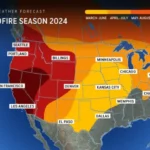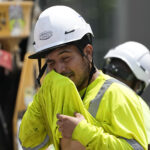The idea is certainly audacious: Thwart traffic in congested cities by flying over it. Quick, quiet, clean, cheap.
This concept—which requires a new type of battery-powered vertical takeoff and landing vehicle (VTOL)—is Silicon Valley to its core in terms of self-liberation and greater efficiency. These electric vehicles would operate from “vertiports” situated around urban areas, predominantly atop buildings. And, at some point in the future, they would be unmanned.
“In the nerd hierarchy of needs, the flying car is up there with downloadable brains and a working holodeck,” Bloomberg Businessweek noted last year in a profile of Google co-founder Larry Page’s aviation ambitions and the seemingly never-ending quest for personal flight. Well, those nerds are still at it.
Uber Technologies Inc. disclosed the initial steps of its air-travel vision this week, announcing five partner companies with various specialties aimed at making the sci-fi staple affordable and common. The initial testing is expected in 2020 in Dallas and Dubai, two car-clogged cities where aviation interests wield great influence.
“If you’re not planting the seeds for five, 10 years out, you have no company in five to 10 years,” Jeff Holden, Uber’s chief product officer, said.
Plenty of startups want to hasten the day when we all have a flying car, but Uber and its partners see an air taxi as the logical first step. The company released a white paper in October to discuss its views of on-demand urban air transportation.
Yet even with a limited foray into the world of George Jetson and Blade Runner, it’s hard to overstate how many fundamental achievements must occur first, on both regulatory and technical grounds, before anyone can summon a cab from above.
No one has built a craft of the sort Uber envisions, much less one that flies three or four people quietly on batteries powering multiple propulsive rotors. Battery technology has years of advances to go in order to become smaller and lighter, two attributes critical for an efficient VTOL.
Even the simple matter of naming these things isn’t that simple after all. A flying car? Nope, the future multi-rotor craft will not even be close to an automobile. Nor is it a smaller, more technologically-advanced helicopter. And whatever the consensus on nomenclature, given the expense—Uber suggests a long-term cost around $200,000—it’s unlikely large numbers of motorists will be trading in their ground cars for flying transport. In fact, at first these vehicles may be too exotic even for sky tripping taxi fleets. Given the intense focus on offering air travel at the lowest possible cost, to make it a service for the masses, an air shuttle seems more apt for cheaper fares.
And any new aircraft design will in turn require new standards, new regulations, new government certifications of those standards, as well as software testing since programs will be needed to help fly the aircraft.
Despite all of these daunting challenges and unanswered questions, the usual suspects are nevertheless lining up. Textron Inc.’s Bell Helicopter sees the business as one that could lead to an entirely new product line, begun with hybrid motors before morphing into fully-electric designs. Embraer SA, which, like Bell, manufactures both civilian and military aircraft, is also hoping to supply VTOLs, along with future generations of computer “fly-by-wire” technologies needed to make these aircraft work without pilots.
Given this innovation, the Federal Aviation Administration is keen to be seen as helpful, noting in a statement that the agency is working on automation systems for unmanned aerial vehicles. That technology could eventually have a place in the VTOL world. “Several areas need further research, particularly identifying the operational risks, making sure the automation that ‘flies’ the autonomous vehicle is safe, and how the automation will interact with the air traffic control system,” the FAA said in a statement in response to queries about such aircraft.
That last point is a big one as far as the FAA is concerned: How do you integrate these aircraft into U.S. airspace? It’s a complex subject commercial drone aspirants are already exploring with regulators, and one fraught with difficulties.
A VTOL flight also presents practical considerations closer to the ground: Most commercial and residential buildings locate their entrances on ground level, which could complicate the arrival of people landing on the roof. (This is also where a Jetson-style jetpack could come in handy.) In a VTOL world, many existing buildings will have to retrofit their roofs while some new buildings will require landing pads.
“How quickly it scales is anybody’s guess, but they’ve got the demand.”
Officials at Uber and Fort Worth-based Bell stress that these vehicles will be commercial aircraft requiring roughly the same level of safety as charter aircraft. Regulators and the public won’t abide anything less and any air-taxi business could easily ground itself with just one crash.
Uber says its goal is to make the cost of urban air transport, when pooling riders, comparable to its lower-cost UberX ground service. In the long term, Holden said, the cost of flying by VTOL will become lower than the “variable costs” of owning a car, including such expenses as insurance, maintenance, tolls and fuel, given the economies of scale that would come from high production and utilization rates.
“There are a lot of compelling elements to this vision,” said Brian Wynne, president and CEO of the Association for Unmanned Vehicle Systems International, who attended the Uber event in Dallas this week where the plans were unveiled. Wynne, who’s also a former director of the Electric Drive Transportation Association, which promotes battery, hybrid, and fuel cell tech, predicted the ongoing marriage of electric motors with autonomous technologies for smaller commercial drones will help power the air shuttle field.
“Whether this becomes a niche service … and how quickly it scales is anybody’s guess,” he said. “But they’ve got the demand.”
Was this article valuable?
Here are more articles you may enjoy.

 Report: Claims Handlers Embracing Technology
Report: Claims Handlers Embracing Technology  2024 Wildfire Forecast Calls for ‘Below Average’ Season
2024 Wildfire Forecast Calls for ‘Below Average’ Season  Work Safety Group Releases List of ‘Dirty Dozen’ Employers
Work Safety Group Releases List of ‘Dirty Dozen’ Employers  Report: Cybercrime ‘A Thriving Business,’ as U.S. Claims Frequency Rises
Report: Cybercrime ‘A Thriving Business,’ as U.S. Claims Frequency Rises 